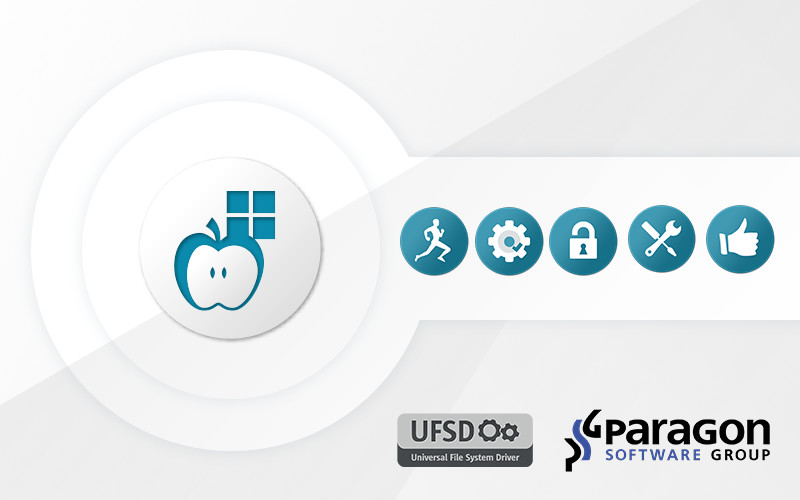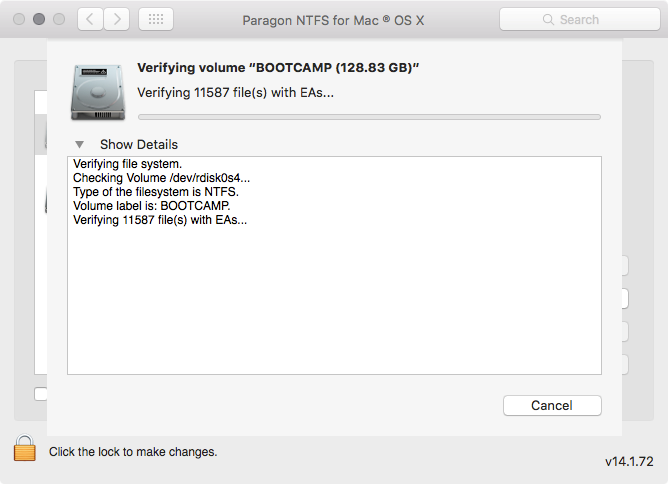Since the release of Mac OS X 10.11 El Capitan, Paragon Software Сustomer Service have received over a 1000 requests concerning the verify/repair/format disk utility options, which disappeared from the Disk Utility in OS X 10.11 El Capitan. To address this issue, we integrated the functionality directly to NTFS for Mac Preference Pane.
Additionally we have recently released a new professional maintenance tool, Paragon Hard Disk Manager for Mac, to help you perform these basic and numerous advanced file system and volume partitioning operations.
If you are in need of such a solution, you can try Paragon HDM for Mac now.
However, in this article we going to show you how to format, verify and repair NTFS volumes with built-in partitioning tools in NTFS for Mac 14 under Mac OS X 10.11 El Capitan.
Disk Utility vs. Third-Party Drivers
The El Capitan version of Disk Utility has been through major changes — both cosmetically and under the hood. Once you get used to the glossy new user interface, veteran users might notice Disk Utility no longer manages disks mounted by third-party drivers, at least not through the program’s graphical user interface. The reasons for the change don’t make a whole lot of sense to outsiders, especially when disks mounted by non-native drivers can still be mounted, formatted, or repaired by using the command-line diskutil.
In addition to the under the hood changes outlined above, the familiar NTFS for Mac preferences pane has been overhauled with version 14. Since Disk Utility can no longer be used to work with Windows-formatted volumes, NTFS for Mac 14 now includes built-in format, verify, and mount functionality.
In addition to Windows NTFS, other file systems supported by OS X can also be used with this preference pane — for example, if Paragon’s ExtFS for Mac driver is already installed on the same system, NTFS for Mac will also be able to format, verify, or mount Linux-native Ext2/3/4 disks as well.
Here’s what NTFS for Mac 14 looks like when launched:
In order to verify or format your NTFS or ExtFS volumes with Paragon drivers, you need to launch the app Preference Pane, select a volume and click “Verify” or “Erase”, depending on what operation you need.
NTFS for Mac 14 also fixes found file system errors during the volume verification process:
For those comfortable with Terminal, the same actions can also be performed with Paragon’s command-line utilities. Advanced users familiar with Unix will have access to additional options through this interface:
- fsck_ufsd_NTFS finds and repairs errors on NTFS disks.
- newfs_ufsd_NTFS formats a volume to NTFS.
- mount_ufsd_NTFS mounts or unmounts NTFS disks.
Support of the Windows NT file system is automatically added to the command-line diskutil during installation of the NTFS for Mac driver.
In case you quite often need not only to verify and format NTFS volumes, but perform more advanced tasks, such as move, resize, copy or even undelete partitions formatted to HFS+, NTFS, ExtFS, FAT and exFAT, try the new Paragon Hard Disk Manager for Mac.
HDM for Mac is not just for backup — it’s a powerful application that covers all aspects of the computer’s life cycle, including drive partitioning, file system optimization and repair functions, data backup capabilities, and irreversible data wiping. It already works with macOS Sierra 10.12 Preview.






“The reasons for the change don’t make a whole lot of sense to outsiders, especially when disks mounted by non-native drivers can still be mounted, formatted, or repaired by using the command-line diskutil.”
So what are these reasons?
Well, according to Apple, the main reason for SIP and all these difficulties is improved user security (agains malware and hackers and obviously in general again popular system software).
It’s actually a sort of a bug.
All file system drivers used to be here: /System/Library/Filesystems
After El Capitan and SIP is out, the new way for system drivers is /System/Library/Filesystems , and for 3rd party drivers /Library/Filesystems.
However, GUI version of diskutil ignores new folder with 3rd party drivers.
At the same time diskutil supports 3rd party via terminal with ease, like “diskutil eraseDisk ufsd_NTFS VOLUMELABEL disk2”
It is possible to install the old version of the disk utility app in addition to the new version published with El Capitan. I did it and it works.
https://justus.berlin/2015/10/restore-old-disk-utility-in-os-x-el-capitan/
Props for doing this. I had no idea that DiskUtil had changed in El Cap until I got a new external HDD (to add to the fleet I currently have).
Had to laugh at the command line ‘fsck_ufsd_NTFS’ though. Given the first part, I can’t help but imagine the middle bit stands for ‘Un-F%$# Sodding Disk’…
@Gerald Schlatte Great article, but kinda risky, isn’t it?
I use three external hard discs on iMac El Capitan: FREECOM USB MS-DOS (FAT); Samsung USB exFAT; Toshiba OS X esteso (journaled). No partitions on the discs.
Paragon NTFS for Mac is installed.
Is this your new release useful for my machine? Do I need it?
@Assunta A. Berardi It’s a very useful piece of software. It includes drive partitioning, file system optimization, repair functions, data backup capabilities and data wiping. It also supports all file systems of OS X, Windows, and Linux. You can try for yourself, it has 10-day trial 🙂
Another try to rip me off my money?! YES!!!!
The main reason I’ve uninstalled Paragon’s NTFS for Mac, is I can no-longer see/select my Bootcamp partition from El Crapitan pref. pane when P-NTFS-Mac is active…
Onyx can do this for free so the price is unjustified in my view if it was $9.99 I would have bought it right away.
No mention of whether it will allow the set up and repair of RAID arrays using multiple external disks, just as the original Apple utility did. Does it have this feature?
@Wim
Just an offer, nothing more 🙂
@Kuloskap
Since OS X El Capitan, built-in utilities like Startup Disk and Disk Utility won’t show drives mounted with third-party file system drivers anymore.
With that in mind, we have introduced additional features in NTFS for Mac preference pane.
You have to use NTFS for Mac’s Set as Startup option to boot from BootCamp partition.
@Ben
Onyx can’t do the rest of features like file system optimization, repair functions, data backup capabilities, data wiping, etc.
@David W
No, it doesn’t have this feature now, but we might add it in the future updates.
@ Sergey Kovchenkov :
I apologize for not being more clear, Sergey:
I WAS referring to the Bootcamp partition disappearing from the “Startup Disk” Preference Pane (OSX 10.11.6) — when Paragon NTFS Mac (v.14) is active.
(Option-selecting a boot volume during startup does not persistently change the default startup, which causes a reboot into the WRONG partition when the WIN OS triggers reboots during software updates…)
@Kuloskap
Ok, did you try Set as Startup option? If it’s not working properly for you, we should take a look at the system logs to find the issue.
So far so good. I’ll let you know if there’s any problem I see.
Hi,
I couldn’t find the same subject for Yosemite so I decided to ask my question here.
Have NTFS 14 (14.2.359) & run Yosemite (10.10.5). Tried to format several flash drives (initially MacOS Extended) to NTFS using either DiskUtility or NTFS 14 Preference Pane. All cases ended up with a single non-mountable “NTFS” partition. These flash drives were unreadable by Windows systems (7 or 10) too. Also, when I was trying to format them in a Windows environment, the only option I was getting was to format 200MB to whatever file system I wanted (NTFS, FAT etc), not the whole capacity (i.e. several GBs). Only solution was to format them using Windows Command Line and get a fully functional NTFS flash drive.
Any ideas why is this happening?
Thanx in advance for any response!
-Michael-
@Michael P
Hi! That’s because Windows doesn’t support GPT-formatted flash drives.
You have to format your flash in Disk Utility from GPT to MBR (Master Boot Record), and then you format this partition in NTFS via NTFS for Mac.
@Sergey
That was really helpful, thank you!
I haven’t noticed that the default in my mac was GPT instead of MBR.
So, I took an MBR formatted usb drive with one NTFS partition, working properly in both Mac & Windows, and with Disk Utility I created 1 NTFS partition by deleting the previous one, keeping in mind to check in “Options…” that MBR is selected again. Result is a non-mountable partition.
I used NTFS 14 Preference Pane, & tried to erase/format using NTFS. The message was:
“Unmounting disk
Erasing
Progress
Formatting Volume …
Creating file system structures.
Creating $UpCase for use in Windows 7 and later versions
NTFS format complete.
Bytes per sector 512.
Bytes per cluster 4K.
115.69 GB total disk space.
115.23 GB available.
Mounting disk
Could not mount disk3s1 with name 129 after erase”
The solution was to erase/format it with FAT32 filesystem first, and then do it again with NTFS (both done with NTFS 14 Preference Pane) and now its working again properly everywhere.
Is Disk Utility not indicated for formatting a drive in NTFS under Yosemite and should it always be done via NTFS 14 & why?
Again, many thanks in advance for any response!
-Michael-